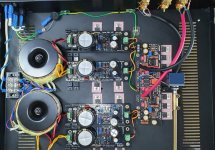But your power amp is going to see higher source impedance from the high pass filter if you will skip its buffer part?
I don't know.
Without buffer the amp see the impedance of two resistors and cap.
If I'll use the buffer, i'll put it between volt divider and cap.
I 'm not an expert one like you Nick.
In my Borbely preamp I checked with and without buffer and the differences was evident.
More control and dinamic with buffer,but before the splitter there is a k170/j74 buffer, not 3 mosfets in TO220 like in DCG3!
Without buffer the amp see the impedance of two resistors and cap.
If I'll use the buffer, i'll put it between volt divider and cap.
I 'm not an expert one like you Nick.
In my Borbely preamp I checked with and without buffer and the differences was evident.
More control and dinamic with buffer,but before the splitter there is a k170/j74 buffer, not 3 mosfets in TO220 like in DCG3!
The DCG3 drives but through what it goes last counts. Maybe also try Rs 1k Rp 0.8k divider that DCG3 can still drive very well and listen.
I'll try this smaller values.
My amp is the Borbely Millenium 200 and input impedance is 1k1 ohm.
My amp is the Borbely Millenium 200 and input impedance is 1k1 ohm.
bearings?
I have a practical build question.
If you use an extension to bring something like a selector or attenuator that is back in the box to the front face plate, what kind of bearing do you use to bring it through the face plate so the knob can be put on it.
Thanks,
Don
I have a practical build question.
If you use an extension to bring something like a selector or attenuator that is back in the box to the front face plate, what kind of bearing do you use to bring it through the face plate so the knob can be put on it.
Thanks,
Don
Hi Don,
I use a simple metal sleeve cut from a piece of 1/4in ID threaded brass pipe. You could also buy something similar on Ebay; look for attenuator/potentiometer shaft extension. This is if you have a sheet metal front plate. If the front plate is thick metal or wood I think a simple hole will suffice. You can of course get carried away and choose to install a roller bearing; look for skate bearings they are small.
nash
I use a simple metal sleeve cut from a piece of 1/4in ID threaded brass pipe. You could also buy something similar on Ebay; look for attenuator/potentiometer shaft extension. This is if you have a sheet metal front plate. If the front plate is thick metal or wood I think a simple hole will suffice. You can of course get carried away and choose to install a roller bearing; look for skate bearings they are small.
nash
One of the cheapest out there
Aluminum 300mm Volume Potentiometer Extension Shaft Audio Connecting Long Rod | eBay
Aluminum 300mm Volume Potentiometer Extension Shaft Audio Connecting Long Rod | eBay
I've used 8mm x 6mm shoulder bushes( available from Farnell) to good effect on 10mm front panels. Similar to To220 bushes.
Hi Salas,
My setup is a dual mono TF with 4 UBiB PSU instead of the standard offering. I am getting a pretty audible hum. What is the best way to ground the setup? TIA
My setup is a dual mono TF with 4 UBiB PSU instead of the standard offering. I am getting a pretty audible hum. What is the best way to ground the setup? TIA
Is there any signal zero or PSU zero wire to your chassis? Is your chassis wired to the mains ground? Upload a bird's eye view photo of the build.
Did you scrape away the paint on the chassis at the grounding point so that you have a good connection and is the body of the pot grounded?
Try something. Disconnect the CL60 from the PE but keep the green/yellow wire connected on its other end. Do the input signal wiring conventionally through the volume pot. Attach the CL60's free end on the volume pot's mounting hardware somewhere conductive. Does something change for hum?
By the way, the UBiB mounting points are isolated islands from its PCB's ground plane. No continuity there.
By the way, the UBiB mounting points are isolated islands from its PCB's ground plane. No continuity there.
Dewdrop how have you connected the four UBib G's to the DCG3 board?
Is this a new DCG3 board or an old one? I remember Salas mentioning that the new DCG3 board has a split G for each side while the old one had a common G.
nash
Is this a new DCG3 board or an old one? I remember Salas mentioning that the new DCG3 board has a split G for each side while the old one had a common G.
nash
Current board should have V1.03 printed with tiny letters at the right bottom corner. I looked in the photo for that and it does not.
Sorry, I didnt answer the other question.
The each ground zero of +/- UBiB pair is connected to the PWR GND of the DCG3 channel.
I connected the left channel HP GND to the pot GND and then the right channel HP GND to a CL60 (yellow green cable) and terminating at the chassis GND.
The each ground zero of +/- UBiB pair is connected to the PWR GND of the DCG3 channel.
I connected the left channel HP GND to the pot GND and then the right channel HP GND to a CL60 (yellow green cable) and terminating at the chassis GND.
- Home
- Source & Line
- Analog Line Level
- Salas DCG3 preamp (line & headphone)
